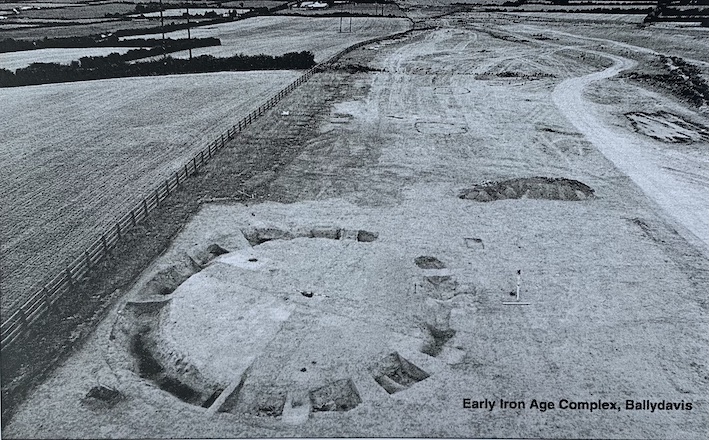County: Laois Site name: BALLYDAVIS
Sites and Monuments Record No.: N/A Licence number: 95E0111
Author: V.J. Keeley
Site type: Ring-ditch and Metalworking site
Period/Dating: Iron Age (800 BC-AD 339)
ITM: E 650977m, N 700777m
Latitude, Longitude (decimal degrees): 53.055202, -7.239591
During archaeological monitoring conducted on the Portlaoise Bypass an extensive Iron Age complex and associated features were discovered in the townland of Ballydavis. A full-scale excavation followed during the period May–Nov. 1995. The site lay atop a low knoll (130 OD), some 4km north-east of Portlaoise town. The approximate area covered was 250m x 130m. The complex consisted of four ring-ditches, seven furnaces, and a series of pits and postholes.
The largest ring-ditch (Site 1) measured 16m in diameter. Its entrance faced due east and measured 3.2m in width. The ditch was substantial and measured up to 0.91m in depth with a maximum width of 2m at the terminals. The interior of the monument yielded a central burial deposit, consisting of a bronze box, cremated human bone and associated artefacts, including a bronze fibula, bronze wire and over 80 beads.
The ditch yielded a significant amount of material, including an iron blade, iron nails, part of a bronze bracelet and a pin fragment. Evidence of metal-working was found in the form of iron slag and crucible fragments. The stratigraphic profile of the ditch indicated a series of well-defined phases of use. The layers containing the artefacts, charcoal and cremated bone were interspersed with sterile layers and slippage. There was one extensive area of burning, which indicated a fire of great intensity burning for a significant time shortly after the ditch was dug. This in situ burning, possibly of a ritual nature, was found opposite the entrance, covering around 33% of the base of the ditch. It was defined by oxidised clay and carbonised brushwood.
Site 2 consisted of a smaller ring-ditch which measured 8m in diameter. It lay some 40m to the east of Site 1. It was sealed under a layer of cobble-like stones. The ditch measured 0.7m in depth and had a maximum width of 1.5m. Its entrance faced south-east and measured 1m in width. Finds from the ditch include four fragments of stone bracelets, part of an iron blade and one fragment of bronze. Animal bones were also found in the ditch.
In proximity to Site 2 a series of shallow pits were found. One of these yielded a bronze fibula.
Two smaller ring-ditches (Sites 3 and 4) were also excavated. Site 3 measured 6m in diameter and lay 26m to the north-east of Site 1. The ditch, which contained a mixed fill of charcoal and burnt bone, measured 0.5m in depth and had a maximum width of 1.2m. There was no entrance to the site. Finds from the ditch include four decorated glass beads, of a similar nature to Guido's 'Meare-spiral' type, three decorated bone pieces, a possible hilt of bone and a bead spacer of stone. The fourth ring-ditch measured 6m in diameter. It had a maximum depth of 0.6m and a width of 1m. The entrance faced north-west and was 2.2m in width. The fill was mixed with a significant amount of charcoal.
Several furnaces were also excavated. These features yielded evidence for metal-smelting and are an indication of the additional aspect of industrial activity on the site.
The box from Site 1 is made of tinned bronze. It consists of a sheet of bronze riveted together along one side. The base is a circular plate of bronze held in place by a binding strip (the lid is similarly constructed and has a centrally placed mount). It measures 110.2mm in diameter and 63.4mm in height. The mount is of iron; it bears red enamel and has a central bronze rivet with a cross-hatch pattern. The bronze handle of the box has a central mounting with three circular knops, each having three concentric circles bearing enamel. The beads are made of stone and of glass. They vary in size from 2mm to 26mm and include rounded and cylindrical shapes. The colours include blue, green and yellow. One of the blue glass beads, according to Guido's classification, is of Class 6a, 'Oldbury' type, measuring 19.8mm x 13.23mm x 8.2mm. The fibula, of safety-pin type, is made of bronze with a scroll-type decoration at the spring. It measures 38.6mm in length. It appears to be of Nauheim type.
Burials reliably dated to the pagan Iron Age are very rare in Ireland and the Ballydavis complex now offers a well-documented site providing both a complex of surprisingly well-preserved monuments and rich finds. The site has similarities with the Celtic royal cemeteries of Cruachain and Tara and with Tumulus 8 at Carrowjames in County Mayo. There are also interesting connections with similar finds in northern Britain and on the Continent. The finds of glass beads and brooches have parallels with similar material from Kiltierney, Co. Fermanagh, and Oran Beg and Grannagh, Co. Galway, in broadly similar contexts. The closest parallel to the box comes from the chariot burial of a female at Wetwang Slack, Yorkshire.
Reference
Guido, J. 1878 The glass beads of the prehistoric and Roman periods in Britain and Ireland (Reports of the Research Committee of the Society of Antiquaries of London, No. 35). London.

29/30 Duke St., Athy, Co. Kildare